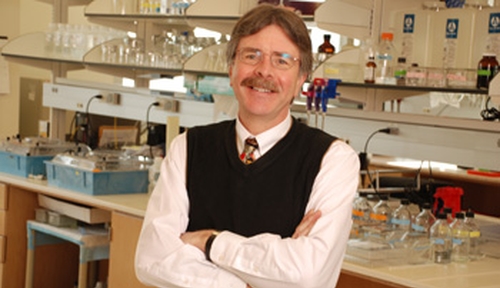UNMC pulmonologist part of team that isolates the culprit
Joe Sisson, M.D., a University of Nebraska Medical Center clinician-scientist, was part of an international team of researchers that has zeroed in on a protein that plays a key role in many lung-related ailments, from seasonal coughing and hacking to more serious diseases such as MRSA infections and cystic fibrosis.
The finding, which was reported in a recent issue of the journal Nature, advances knowledge about this range of illnesses and may point the way to eventually being able to prevent infections such as MRSA. The researchers on the study hailed from several states as well as Mexico and England.
The key protein is called MUC5B. It’s one of two sugar-rich proteins, with similar molecular structure, that are found in the mucus that normally and helpfully coats airway surfaces in the nose and lung. The other is MUC5AC.
“We knew these two proteins are associated with diseases in which the body produces too much mucus, such as cystic fibrosis, asthma, pulmonary fibrosis and COPD,” said Chris Evans, Ph.D., an associate professor in the University of Colorado School of Medicine and the lead author on the study. “We also knew that many patients with asthma or COPD have as much as 95 percent less MUC5B in their lungs than healthy individuals, so we wanted to see if one of these is the bad player in chronic lung diseases.”
The researchers compared mice that lacked one or the other of the proteins. The animals without MUC5B got sick. Those that lacked MUC5AC were fine.
Dr. Sisson, the Larson Professor of Medicine and chief of the UNMC pulmonary, critical care, sleep and allergy division, has been involved in the study over the past two years.
A pulmonologist and NIH-funded cilia investigator, Dr. Sisson’s role was to determine the importance of ciliary motility in mice lacking MUC5B. Cilia are motorized finger-like projections of the cells that line the windpipe and bronchial tubes of the lungs. When cilia beat they create an escalator-like motion producing waves that lift mucus up and out of the lung. This function is called mucociliary clearance and is critical for normal lung health.
“We established that MUC5B is a really important component of the lung’s mucociliary clearance system,” Dr. Sisson said. “If you don’t have MUC5B, airway clearance fails even though airway cilia motility appears to be normal.”
Although mucus serves an important role in the body, Dr. Sisson said it also can be a source of discomfort and annoyance if your body starts to produce too much of it or is not able to clear the mucus that is normally made. An overabundance of mucus may be a sign of an infection with a new virus or bacterium.
Because your body is trying to fight off this infection, it begins to overproduce mucus, which leads to symptoms such as sinus pressure, congestion or a runny nose. Although these conditions are certainly inconvenient and uncomfortable, they actually indicate that your body is defending itself .
Dr. Sisson said the sticky nature of lung mucus has always made it difficult to study.
“Dr. Evans’ genetic knock-out mouse system helped us clearly define the critical role MUC5B plays in the lung’s mucociliary transport system independent of ciliary function,” he said. “These findings add another piece to the delicate interplay between cilia and mucus, which is crucial to protect the lungs from inhaled particles, dusts and infectious agents."
The study also noted that the immune systems of the mice without MUC5B failed over time. That made the mice more vulnerable to infections including the MRSA Staph “superbug,” a major source of infections in hospitals and in the community, especially in people whose immune systems are compromised, such as cancer patients.
“That has interesting implications for anyone with a runny nose,” Dr. Evans said. “Getting rid of your mucus may make you more comfortable and may help patients with chronic lung diseases. But if you block it too effectively, this actually could be harmful in the long run. If a treatment gets rid of MUC5B, it may make people more vulnerable to additional infections.”
An oddity of the proteins being examined is that they are encoded in a part of the human genome that is highly variable. Twenty percent of the population carries a DNA mutation that makes them produce about 30 times more MUC5B than normal.
More research is needed to learn whether people with that mutation are more or less susceptible to infections, including MRSA, said Dr. Evans, who is in the CU medical school’s Division of Pulmonary Sciences and Critical Care Medicine. It’s also unclear what’s happening at a molecular level that allows MUC5B to help control certain infections.
“Knowing the key role of MUC5B allows us now to focus on how the protein works and, we hope, to find ways to help patients with these diseases,” Dr. Evans said.
